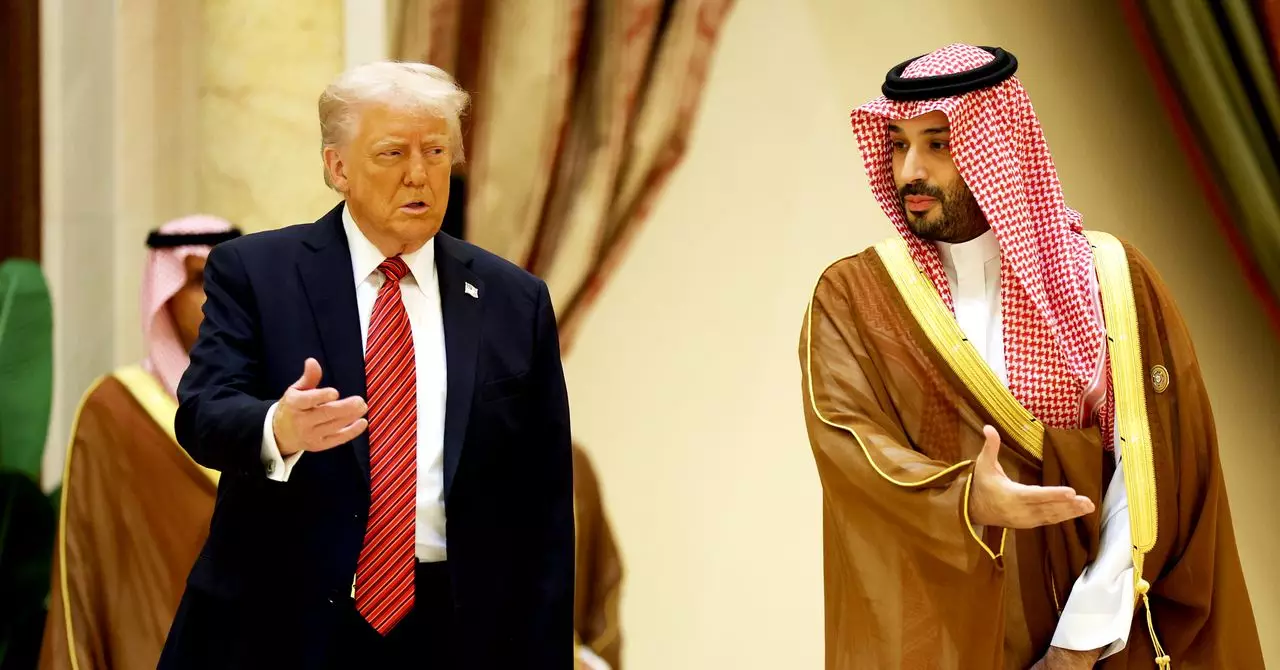Donald Trump’s recent visit to the Middle East, characterized by an entourage of influential tech entrepreneurs and a flashy fighter-jet escort, symbolizes more than just political diplomacy; it represents a transformational pivot in global technological alliances. The focus of this high-profile trip was artificial intelligence (AI), a sector primed to redefine economic and geopolitical landscapes. With ambitious initiatives like the establishment of the largest AI data center cluster outside the United States, the Middle East is positioning itself as a significant player in the global tech arena.
During a high-stakes announcement in Abu Dhabi, Trump revealed that unnamed American firms would collaborate with G42, an Emirati tech powerhouse, to create an impressive five gigawatts of AI computing capacity in the UAE. This venture holds the promise of catapulting the region’s profile as a hub for groundbreaking research and sustainable development, in alignment with Sheikh Tahnoon bin Zayed Al Nahyan’s vision for the UAE. It’s a bold step that indicates how rapidly shifting geopolitical synergies can reshape technological advancements on a global scale.
Investment Waves: Saudi Arabia’s Aggressive AI Strategy
In a thrilling prelude to Trump’s visit, Saudi Arabia announced the launch of “Humain,” an AI-focused investment firm backed by the kingdom’s Public Investment Fund. Early partnerships with tech bleeding giants—Nvidia, AMD, Qualcomm, and AWS—mark a strategic and aggressive approach to building a capable AI infrastructure designed to rivet international attention. Trump highlighted the hefty financial commitments underlying these ventures, announcing upcoming deals worth hundreds of billions of dollars focused primarily on technology and infrastructure.
What stands out in this scenario is how these partnerships with leading tech companies can potentially elevate the region into an essential participant in the cutthroat global race to pioneer advanced AI technologies. Analysts such as Paul Triolo, from DGA-Albright Stonebridge Group, emphasize that this deals’ ramifications extend beyond the Middle East, underscoring America’s intention to cement its silicon dominance while simultaneously empowering burgeoning tech ecosystems in the Arab states.
The Implications of Technological Empowerment
The Saudi investment in Nvidia is particularly noteworthy, promising to deliver 500 megawatts of AI computing capacity that includes several hundred thousand GPUs over the next five years. These chips, renowned for their efficiency in training cutting-edge AI models, could shift the balance of AI innovation. For instance, Nvidia’s GPUs, which excel in both training and inference tasks, could facilitate Saudi Arabia’s ascent to the forefront of AI development.
AWS’s commitment to establish an AI infrastructure zone in the kingdom reflects only a fraction of the multi-billion dollar trajectory that the region is pursuing. Moreover, the collaborative investments—$5 billion by AWS and $10 billion with AMD—highlight how entrenched companies are in reshaping the socio-economic fabric of nations seeking to become high-tech hubs.
The financial muscle of these investments is further amplified by the region’s substantial oil wealth, which gives it the resources necessary to jump into high-tech industries. However, underlying tension remains. The intertwining economic relationships with China complicate the narrative, as these Middle Eastern countries find themselves at a crossroads influenced by a broader geopolitical rivalry centered on AI advances.
Shifts in Regulatory Landscapes
Interestingly, Trump’s administration moved to reverse a significant Biden-era directive that would have hampered the sale of advanced chips to nations like Saudi Arabia and the UAE. This shift hints at U.S. intentions to avoid pushing its partners into Chinese technological dependency. The former regulations were criticized as potentially stifling American innovation and creating an uneven playing field that could encourage Arab nations to pivot towards Chinese solutions.
As the U.S. Bureau of Industry and Security elaborated, the decision aims to enhance American competitiveness rather than restrict it. However, this bold strategic maneuver reflects a critical blend of diplomacy and developmental imperatives. By enhancing access to advanced technology, the U.S. is sending a clear signal—promoting an ethos of collaboration over competition, at least within the confines of cooperative AI advancement.
The Road Ahead: What Lies in the Balance?
As the dust settles on these groundbreaking announcements, the region’s trajectory remains uncertain yet overwhelmingly promising. The strategic partnerships formed between the U.S. and Middle Eastern nations signal the dawning of an era where collaboration thrives amidst competitive technology landscapes. The balance of innovation, regulation, and geopolitics will play a defining role in determining the extent to which these partnerships realize their ambitious goals.
As nations wrestle with the dual goals of amplifying their tech capacities while maintaining sovereignty over their digital ecosystems, the dynamic interplay among business interests, state strategies, and international relations will continue to evolve. With such high stakes involved, one can only watch closely as these partnerships transform into pathways for an innovative Middle East, potentially reshaping the very essence of global AI evolution.


Leave a Reply